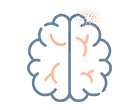Spalice, A., Parisi, P., Nicita, F., Pizzardi, G., Del Balzo, F., & Iannetti, P. (2009). Neuronal migration disorders: clinical, neuroradiologic and genetics aspects. Acta paediatrica (Oslo, Norway : 1992), 98(3), 421–433. https://doi.org/10.1111/j.1651-2227.2008.01160.x
Stouffer, M. A., Golden, J. A., & Francis, F. (2016). Neuronal migration disorders: Focus on the cytoskeleton and epilepsy. Neurobiology of disease, 92(Pt A), 18–45. https://doi.org/10.1016/j.nbd.2015.08.003
Guerrini, R., & Parrini, E. (2010). Neuronal migration disorders. Neurobiology of disease, 38(2), 154–166. https://doi.org/10.1016/j.nbd.2009.02.008
Liu J. S. (2011). Molecular genetics of neuronal migration disorders. Current neurology and neuroscience reports, 11(2), 171–178. https://doi.org/10.1007/s11910-010-0176-5
Vélez-Domínguez L. C. (1998). Trastornos de migración neuronal [Neuronal migration disorders]. Gaceta medica de Mexico, 134(2), 207–215.
Verrotti, A., Spalice, A., Ursitti, F., Papetti, L., Mariani, R., Castronovo, A., Mastrangelo, M., & Iannetti, P. (2010). New trends in neuronal migration disorders. European journal of paediatric neurology : EJPN : official journal of the European Paediatric Neurology Society, 14(1), 1–12. https://doi.org/10.1016/j.ejpn.2009.01.005
Roberts B. (2018). Neuronal Migration Disorders. Radiologic technology, 89(3), 279–295.





